Personal Stories
Recovery Story
by Caroll Montague Price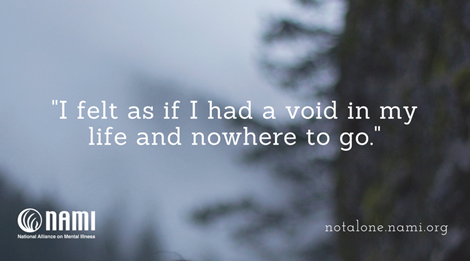
When I was 26 years old, my symptoms of mental illness caused many problems for me. I started to have emotional problems for the first time and was hospitalized in Texas. One of my darkest moments was when I was having a lot of fear and feeling angry about life. In addition, not getting along with family and friends was causing problems for me in my life. I was not able to hold a job and was having dealings with the police. I felt as if I had a void in my life and nowhere to go. Not being able to function in society was a problem for me. These are some of the feelings I was experiencing at my first hospitalization.
Having acceptance of my mental illness means taking charge of my life and moving forward. This has played a big part in my recovery. I started to have acceptance of my mental illness after giving myself credit for my strengths and weaknesses and accepting my limitations. Also, believing that I have something to offer in society and doing positive, healthy things in my life. Not giving up in life has been a positive thing for me. It has helped me to make a lot of progress in my life. In my journey as a Peer Support Specialist and being involved with NAMI has helped me with acceptance. Also, having family, friends, and being a student has very much helped me to accept my mental illness. Staying in treatment and taking my medications has also helped me with acceptance.
It is very important for me to use coping skills that can help me get through a tough day. Having good coping skills for me, means I have a plan in managing my mental illness. There are several coping skills that I use. You can take a hot shower, listen to music, watch television, and keep a balance with your schedule during the week. Medication is also important to me and my treatment. Also, take plenty of breaks when you are doing your school assignments and do not procrastinate in getting your homework done. It’s a good idea to have a good support system to help manage your symptoms and people who can help you with moral support. Also, I make sure to get enough sleep and eat healthy, plus exercise. I want to make sure to keep a balance in my life and have activities to do during the week. It’s been beneficial for me to be attend my support group meetings at NAMI, which has been a big part of my support system. I like facilitating groups and making friends. Basically, pull something out of your toolbox to help you cope better. This helps you cope better when you are having a bad day.
Knowing that hope is the “cornerstone of recovery,” and believing you can have success with your life is critical. Your successes and dreams take on many different directions to arrive at your destination. Success means to me means building upon my strengths and moving forward in my life. Hope means that you believe in yourself and feeling positive never accepting defeat.
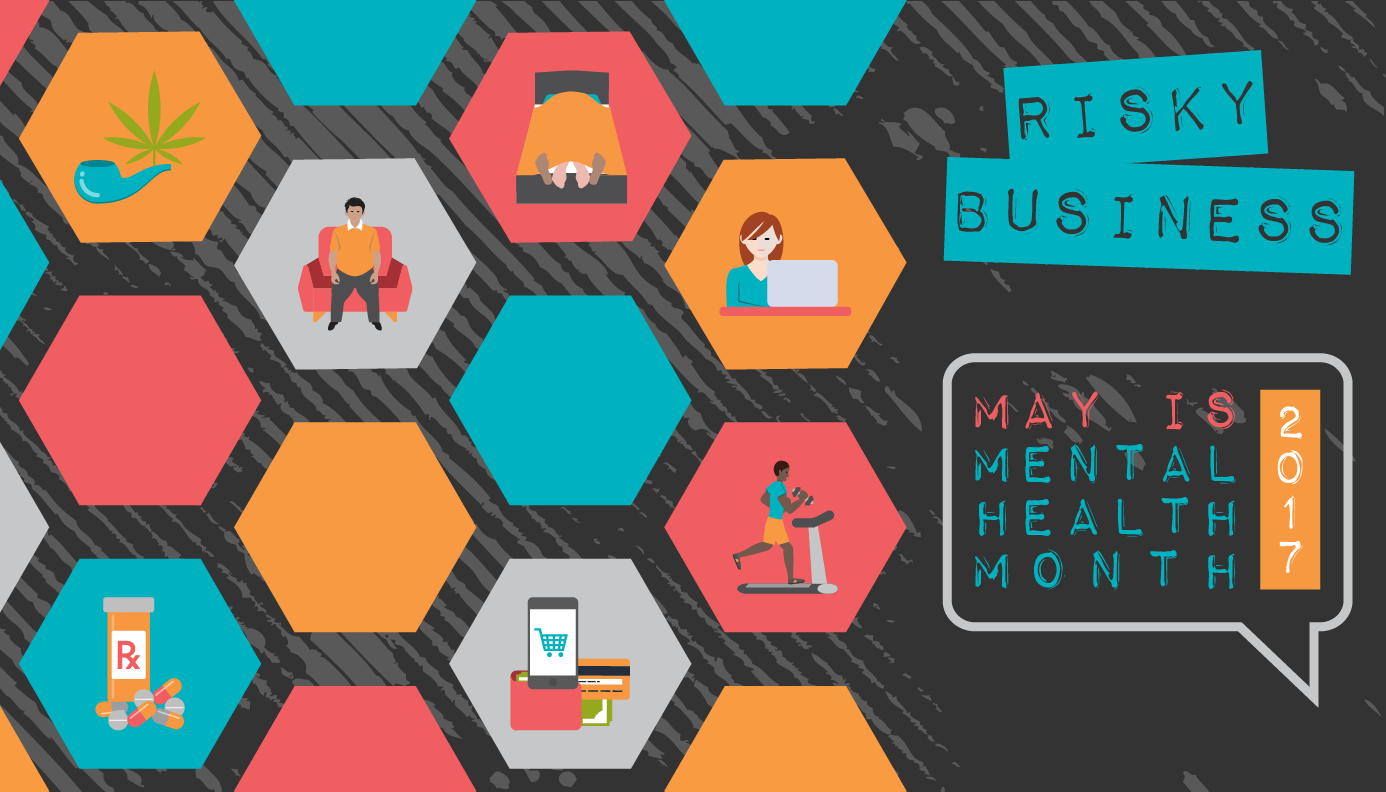
It Takes Courage, but You Can Do It.
For most of my life I have described myself as an extreme person. Not in the Bear Grylls sense of jumping out of planes and drinking weird things, but rather in the sense that I never did anything moderately. It was all or nothing.
I either slept a lot or not at all.
I was either too exhausted to move or so full of energy I would exercise for hours on end. I would either study obsessively or skip my classes for days.
I would either eat everything or nothing at all.
I was either extremely sad or the happiest person on earth.
The truth is I knew this wasn’t normal, but I felt that this was just who I was. I had been dealing with these ups and downs for as long as I could remember, as far back as when I was just five years old. But as I got older I realized I could no longer reconcile the ups and downs of my mind with the unpredictability of “the real world.” Death and illness are inevitable parts of life, but coupled with my internal struggles, these things sent me into a total tailspin.
My freshman year of college was pretty rough. I was all over the place and generally out of control. In the spring, I hit a wall. The constant back and forth was exhausting, not to mention I had also had mono for five months. I decided then that I needed to take care of myself.
The past few years since then have been a journey. I’ve started, stopped and restarted basically every form of treatment. At several points I’ve thought “Oh, I’m better now. I’ve moved on from that and I don’t need to do anything else.” But that has never turned out to be true. One of my best friends always says, “the stuff you have is the same stuff you’ll carry for life, so you might as well deal with it.” It’s taken me a while to fully embrace that. There’s really no such thing as “getting better,” but you can get better at dealing and living with mental illness. Taking care of yourself is a lifelong project.
To be honest sometimes I do wonder why I have to be like this. People always say “Oh I wouldn’t change my mental illness if I could, it’s made me who I am!” Sometimes I think that’s ridiculous, but truthfully it has made me who I am. I think that everything I’ve gone through has given me a great perspective and outlook on life. There are a lot of things I don’t worry about because I know that in the grand scheme of things they won’t matter. Instead I appreciate and embrace the little things, things that just make me smile or laugh. I still have ups and downs, but I finally have a routine of self-care and I’m in control.
My hope in writing this isn’t to get any sympathy. There’s nothing tragic or pitiful about mental illness. I’m also not trying to reveal some big secret because I’ve never really tried to hide any of this. I really just want to contribute to the dialogue surrounding mental health. It’s okay to talk about it - it’s actually great to talk about it! I’ve found that when I share my experiences with others they generally understand and can even relate. Discussing mental health reduces the stigma.
Commit to taking care of yourself. There’s nothing beautiful or romantic about mental illness. Nobody should suffer through it. Take it seriously, but at the same time laugh about it when you can.
Go to the doctor.
Go to a psychiatrist.
Go to a therapist.
Take your meds.
Work on yourself.
Forgive yourself.
There may be people who don’t understand and incorrectly judge you, but there will also be people who care for you and will be there for you. I can’t express how thankful I am for those who have been and continue to be patient with me.
Everybody deserves to be in control of themselves.
Everybody deserves to be understood.
Everybody deserves to be happy.
Everybody deserves to live their best life.
It takes some courage, but you can do it.

Opting for Change in the Face of Fear by Anne Ball
My name is Anne and I am a 34-year-old mother of two children: Maxine, aged 13, and Sarah, aged 8. When I look out of my kitchen window to observe my girls playing in the background, I pray that they always stay the way they are – energetic, fun, strong… Maxine is now entering adolescence and sometimes gives me cheeky responses to my questions, asserting her need for independence and clearly getting annoyed if she feels I’m being too motherly. She is nothing like I used to be at her age and I must say that is the best gift she could have given me.
When I was 12, I embarked on a dangerous road that nearly took my life. After being called ‘porky’ and ‘chubby’ by a group of classmates at school, I began severely limiting the amount of food I ate. As the kilos dropped off me, everyone told me how good I looked – my parents, my friends and the teachers at school. It is funny but now, when I look back at pictures of when I was 11 and 12 (before the anorexia), I do not see a child in need of weight loss; I see a happy, strong child who used to love running and swimming and who loved having meals with the family.
By the time I was 13, I was skinny; a few months after my 13th birthday party, mom first expressed her worry to me. I normally hid my thin body
behind baggy clothes but once, she peeped into my room when I was changing and saw my ribcage peeping out through my skin.
She was alarmed and began putting the pieces together. I hardly ever ate with the rest of the family, she noted, yet that was nothing new since in our home, family meals were a rarity. All of us had busy schedules and Mom would normally cook a meal and
leave us the freedom of heating it whenever we were ready. She hadn’t noticed, therefore, how I would serve myself a portion and throw it down
the garbage disposal when nobody was looking.
At this point in my life, the bullying grew worse than before. The same crowd that used to call me fat, now teased me for having an eating disorder. It didn’t matter how much weight I lost, they said, since I was still ugly, pathetic, and dumb. The pain I felt led me to punish myself more; in addition to consuming just one potato or one tub of yoghurt a day sometimes, I also began exercising excessively, going for runs or bike rides. Once, I fainted while I was biking. I was lucky that a neighbor found me and took me home. It was dark at the time and I still shudder to think of what might have happened if the wrong person had found me. I was hungry, weak and dizzy; I think that was when I hit rock bottom.
Mom took me to an eating disorders center, where I was attended to by doctors, a nutritionist and my therapist, Jean, who I am still in touch with today. Jean helped not only me, but my whole family, helping them heal by pointing out that my eating disorder was nobody’s fault – not theirs, or mine… we learned that eating disorders like anorexia have a variety of causes. Sometimes, they can be prevalent in the family; Mom recalled that when they were children, my Aunt Martha had also suffered from an eating disorder (bulimia). At other times, an intense perfectionism can lead us to aim to achieve unrealistic body types. Bullying can exacerbate an obsession with perfection, since it lowers our self-confidence and promotes feelings of guilt and shame.
I was in the center for various months. At first, it was a struggle just to gain weight, despite the fact that I was eating so many calories – much
more than before the disorder had struck. As I gained weight, little by little, I started feeling more energetic. More importantly, I felt like I
could think more clearly and see how if I kept going the way I was, I would lose my life. Anorexia nervosa has the highest mortality rate of any mental
condition.
Now, at 34, I am in a healthy weight range and I exercise regularly, without going overboard. When I feel the urge to criticize myself in my
head or to chastise myself for something as silly as indulging in a ‘sinful’ treat, I remind myself that life is short and that food is one of
its great pleasures. I also know that food is the vital fuel that enables me to feel physically and mentally fit enough to carry out the most
challenging hurdle of all – simply being a Mom!
 Many Thanks to our friends at NAMI for the following personal story of hope
Many Thanks to our friends at NAMI for the following personal story of hope
Turning Corners
07.12.16
My story is not that dissimilar to others that have been shared on this site. My mental illness is complex. Some say I have Borderline Personality Disorder – others think it is Bipolar II with Depression. It really matters very little which it is or even if it is both. The diagnosis changes little about how I experience my mental illness on a daily basis and how it affects my ability to get through each day.
Every day, my mental illness challenges me. It tries to keep me in bed. I curse the moment each day I wake up alive. The notion of getting out of bed each day is exhausting before I have even moved a muscle and the thought of having to deal with other people in the world makes me anxious. It tries to make me late for appointments. I know I should go to group and go to see my therapist, but my brain is determined to convince itself that those appointments are useless anyway as there is no fixing me. It tries to make me not eat. After all, what is the point of eating when I am not hungry anyways? It tries to make me not take my medications. Because it isn’t really helping me anyways, right? It tries to make me hurt myself. If I can hurt on the outside, then I will hurt less on the inside. Too often it tries to kill me. Because I am absolutely certain the world would be better off without me here.
The combination of my depression, the self-harm I do and my chronic suicidality makes me difficult to be around sometimes and at other times, I am funny, quick witted and an asset to others. Sometimes my friends pull away from me because they don’t know how to handle my outburst of emotions and often times I push and shove my friends away because if they get to close and see too much of me at my worst, they might abandon me and that would destroy me.
890 days ago, I tried to end my life. I was absolutely certain that was the best thing for me and everyone else around me. I felt as if my mental illness had gotten so bad that everyone would be much better off without me. I was so convinced of it in fact, that when I woke up in the hospital later, there was no sense of joy at being alive. No relief that I had been found. Just a profound sense of anger and resentment that I was still alive. I wanted nothing more than to have been successful in my attempt to rid not only everyone else from the burden I had become, but more importantly, I wanted to rid myself of that burden. And I only knew one way to do that and it had been interrupted by a lifesaving intervention to the hospital and after, a mental hospital.
I am in a DBT group now and though I was certain at first that there was no possibility that it could work, I have to admit that to my surprise, it is slowly working. It is not easy…I would never claim that, however, I once thought of myself as “unfixable” and now I am less convinced of that being an absolute truth. It is not all cupcakes and picnics. There are still miserable days that I go through, but now I have help that I didn’t have before. I have skills now that can help me out in the worst of times and I am very fortunate to have some very dedicated friends on my side that includes my facilitators at my DBT group.
And through all this, sometimes I find hope in the strangest places. A friend who checks in on me just at the right time. A day where I spend more time laughing than being afraid of what might be my future. Or maybe just my own head remembering that there are many people out there who care about me.
I won’t venture so far to say that I am positive that I have absolutely turned the corner if you will and am on a path of “making a life worth living” but I do know I am closer to being on that path then I was 890 days ago.
- See more at: http://www.nami.org/Personal-Stories/Turning-Corners#sthash.ae7YUlF9.dpuf
Unheralded Heroes of the Animal Kingdom
There’s no question that therapy animals are some of the world’s most unheralded heroes. The ability of other species to help heal their human friends is nothing short of miraculous. And help, they do. From children’s hospitals to nursing homes to veteran centers, therapy animals do good works at all kinds of facilities and with all kinds of patients. These relationships benefit the animals and humans, both, and often open people’s eyes to the amazing abilities of animals beyond traditional roles as household pets. And today’s therapy animals aren’t just cats and dogs either.
Rojo, Therapy Llama & Napoleon, Therapy Alpaca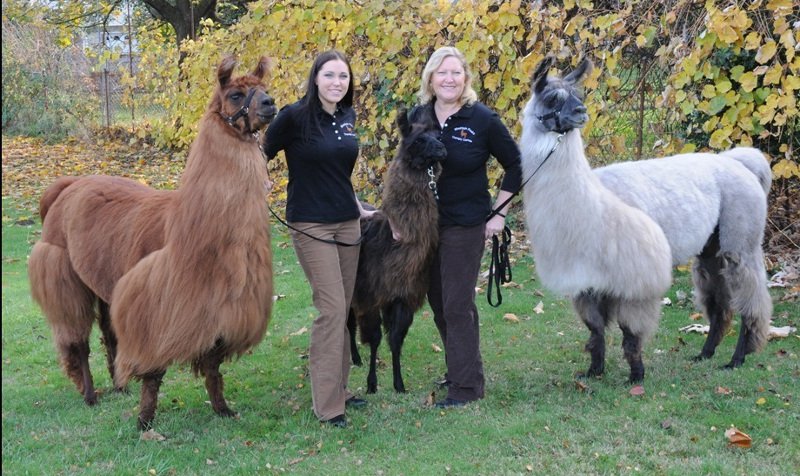 Mountain Peaks Therapy Llamas & Alpacas
Mountain Peaks Therapy Llamas & Alpacas
Dogs and cats aren’t the only critters in the animal therapy game. Just ask the folks at Mtn Peaks Therapy Llamas & Alpacas in Vancouver, Wash. Rojo and Napoleon are getting famous for their frequent visits to local hospitals, rehab facilities, and schools. Nationwide, only 14 llamas are registered as therapy animals, according to Mtn Peaks, which makes Rojo pretty unique, and the team has made over 800 therapy visits since he was first certified back in 2007.
Spartacus, Akita Therapy Dog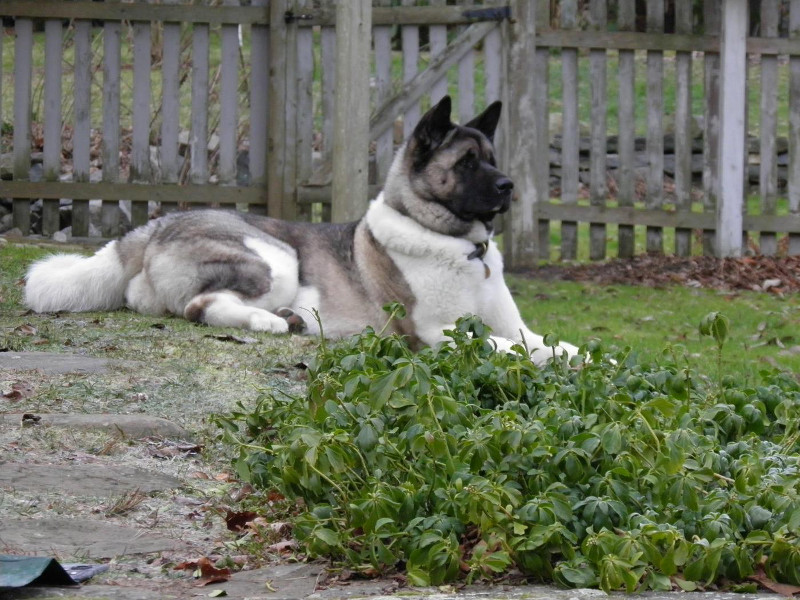 About.me
About.me
When the horror happened at Sandy Hook Elementary, in Newtown, Conn., Spartacus, an Akita therapy dog, was among the first on scene. He remained on campus in the months that followed, offering support and companionship to the traumatized students, teachers, and other responders. His impact even helped lead Connecticut government officials to pass a new law that mandates all victims have access to therapy dogs within 24 hours of a crisis.
Hector, Pit Bull Therapy Dog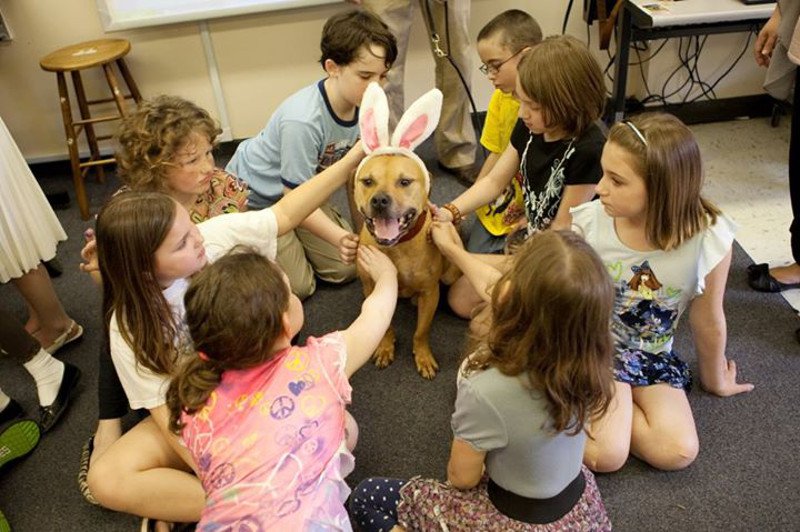 Hector the Pit Bull/Facebook
Hector the Pit Bull/Facebook
One of the 47 victims rescued from Michael Vick’s dogfighting operation back in 2007, Hector faced a world of hurt as a young pup. But after his rescue and subsequent adoption, Hector’s new owners had him trained as a therapy dog. These days, Hector’s motto is “The only thing I fight is discrimination,” and judging by his Facebook page, he spends his time playing in meadows, sleeping in the sun, and visiting schools to teach kids compassion towards animals.
Lexy, German Shepard Therapy Dog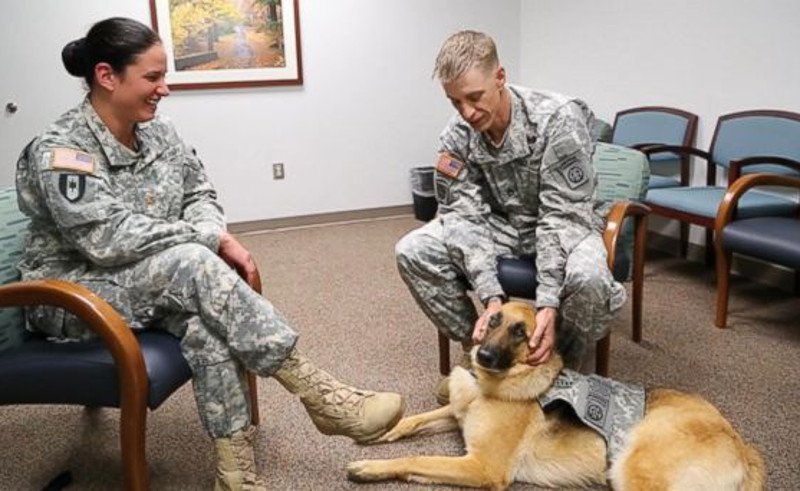 Michael Koenigs via ABCNews
Michael Koenigs via ABCNews
Partner to 82nd Airborne psychiatrist Maj. Christine Rumayor, dedicated Lexy serves her country by supporting members of the military at Fort Bragg. With the rank of lieutenant colonel, she’s the fort’s only therapy dog. In addition, she’s helping to further the cause of pet-supported therapy for soldiers dealing with postwar stress and other trauma. She often allows soldiers to overcome any stigma about seeking treatment.
Buttercup, Therapy Pig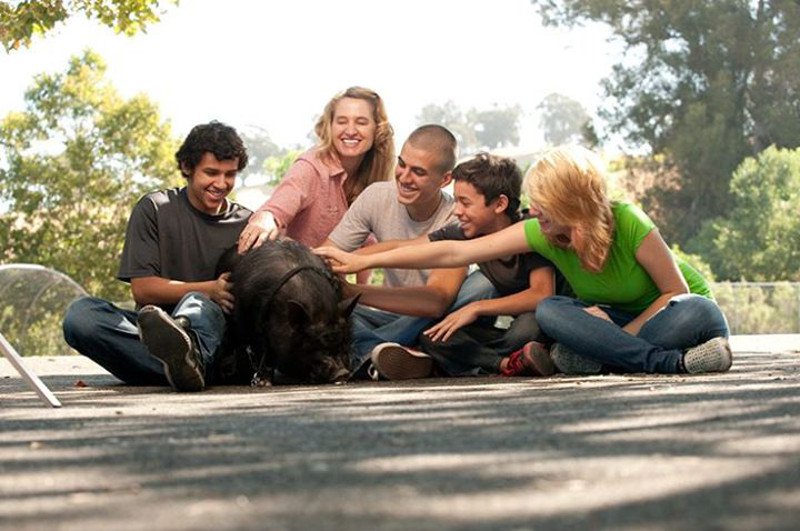 Buttercup/Facebook
Buttercup/Facebook
This adorable, 70-pound miniature Vietnamese pot-bellied pig has a talent for working with special-needs kids. Her partner is speech pathologist Lois Brady, and they spend their time visiting San Francisco schools. Buttercup is super calm and easygoing manner makes her a huge hit with kids who might otherwise be afraid. She helps autistic children improve their social skills, and one severely autistic boy even spoke to his classmates for the first time after stroking Buttercup, her owner told Reader’s Digest.
Elsa, Pit Bull Therapy Dog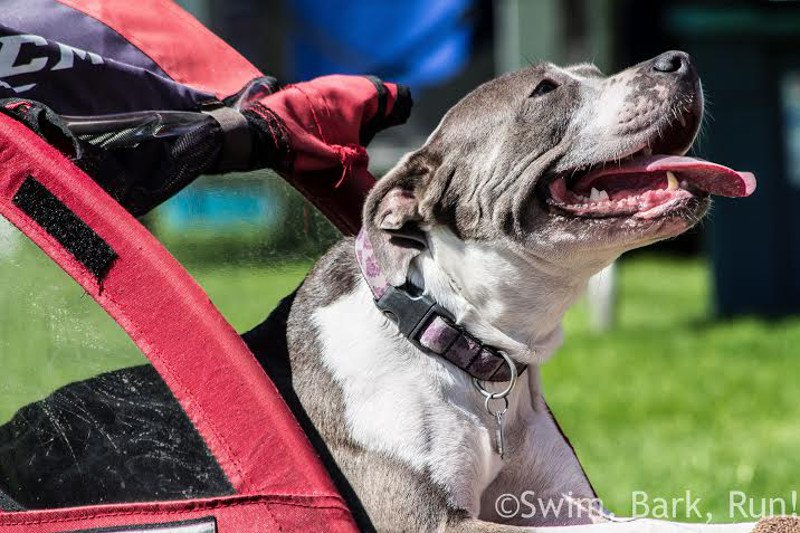
Elsa’s young life was marked by abuse and neglect, and at one-year-old she suffered an embolism that left her back legs barely functional. Eventually, the lovely lass came into the care of Kelly Dann, who got her into physical therapy and registered her for a pet visitation program. Now, Elsa (winner of the British Columbia Society for Prevention of Cruelty to Animals’ “Animal Hero Award” in 2013) visits long-term care patients as well as those suffering from spinal cord injuries. She can move a bit on her own, but most of the time, she’s fitted with a special cart.
Xander, Pug Therapy Dog Meet Xander/Facebook
Meet Xander/Facebook
Having had both his eyes removed after an accident as a young pup, Xander looks a little different. But blindness hasn’t stopped this adorable pooch from living life to the fullest — and that’s the message he imbues to his patients. The little pug helps comfort victims of child abuse, working with organizations like Klamath-Lake CARES and Hands and Words are not for Hurting. He gives kisses, brings smiles, and inspires folks all over the place.
Sheba, PFC Mascot
And finally - last but by no means least - Sheba the Phoenix Family Center Mascot.
visit http://www.onegreenplanet.org for more great stories of animals helping humans!
“Un-depressed”
Depression was the word that doctors gave to the state in which my will to live had been exhausted. It is as good as any word can be in describing a condition which, like many other mental illnesses, exists mainly in the terrain between and beyond the reach of words.
There is no word to describe what it means to become un-depressed. Undoing depression is no less simple than doing it. It took me several years. Depression is not itself a condition which needs to be cured. Depression is nothing other than the psyche announcing on behalf of the organism that it is unwilling to put up with any further violation of its right to exist. It has most in common, I believe, with the pains of childbirth. Pain which is borne by both mother and child and which places each in genuine danger, but which accompanies and is the truest registration of the miracle of life.
That I did not kill myself is a miracle of life too. It would not have happened had I not met the most wonderful therapist. Anti-depressant medication helped too, providing the space for the slow, arduous work of reconstructing a self from the ruins of a statue. I have no advice for anyone. I have only my own example, which continues to reveal itself to me with all the awkwardness that would accompany someone who, after half a lifetime of paralysis, attempted one day to learn to walk.
Tony Hughes-d'Aeth is a Lecturer in English and Cultural Studies at the University of Western Australia, where he teaches courses on comparative media and cultural theory. He researches in the area of Australian literary and cultural history. His book Paper Nation: The Story of the Picturesque Atlas of Australasia, 1886-1888 (Melbourne University Press, 2001) won the Ernest Scott and Keith Hancock prizes for history. Currently, he is writing a literary history of the Western Australian wheatbelt.
World Autism Awareness Day

In Honor of "World Autism Awareness Day", here is an article by a young girl from the UK who tells of her experience with Autism.
"In 99% of cases, it's a brat who hasn't been told to cut the act out. That's what autism is."
All I can say is thank goodness most people don't think like that. I was diagnosed with Asperger syndrome when I was nine. I don't remember much about my childhood - I feel left out when my friends talked about how fun school was during reception class.
The only real memory I have of it is hiding under a table, feeling really stressed out. Most of primary school was distressing and all I remember is that I really hated it. I really couldn't deal with being in a classroom with other people all day, when all I wanted was to be alone. I didn't know how to talk to people or make friends and being close to others made me very uncomfortable.
I began to run out of class to be alone, which was so much easier and much more fun. I loved to pace up and down for hours on end if I could and in fact, I still do that nearly every day, whilst listening to my iPod. However, back then if people tried to bring me back into class again I kicked and hit out.
I don't remember being diagnosed, but the result was that I got a full time helper to avoid being excluded. Mrs N. was amazing. She soon became the person I was closest to at school. She was firm, but very kind and funny, and I miss her a lot. I would never have managed primary school without her.
However, things did slowly change for the better. I was told I would get a Gameboy if I didn't run out of class for the whole six weeks leading up to Christmas. It was really hard to do, and I needed Mrs N. every step of the way, but I managed.
People began to wonder about secondary school. My mum and dad thought about a special school but decided against it. So we went round lots of local schools. I hated some because they were so big and noisy. One school told my mum that because I had a statement I would be in the front door if I wanted - but that they would have me out the back door as quickly as they could. Knowing that hurts even now, years afterwards.
Although we looked around many schools I already knew where I wanted to go. My school is all girls, small and really friendly. I fit in and have a group of eight friends, but I get on well with nearly everyone in my class. I only had two friends in primary school. I am doing really well with my lessons and I'm expected A*’s in all my GCSE's.
I'm looking forward to being more independent, starting sixth form and learning to drive. Living on my own will be hard because I find it very difficult to fill in forms or make telephone calls- I had to phone the bank recently and when the man came on the phone I panicked and couldn't say a word!
I'm sure I will manage these things eventually with help from my parents. Some people at school still don't know 'about me'. Until quite recently I guess I felt ashamed of being different, afraid of people's reactions. They wonder about that time in year eight when I screamed and hit out, they wonder why I have two helpers, and I'm sure they wonder why I put on my iPod sometimes, screen everyone out and pace up and down the room.
But they don't ask about it and I'm pleased they don't. I feel comfortable enough around my class to pace in front of them when I need to. My friends don't care - to them that is part of what makes me 'Ellie'. Other than that, you probably couldn't tell anything about me was out of the ordinary if you met me.
Eye contact is difficult and although I like going to the cinema on my own, if a stranger sits next to me I panic and want to leave. But I have learned that if I stay, I will eventually get so absorbed by the movie that I’ll simply forget they’re there!
A while back I made a big step and decided by myself to go to some mock job interviews to help with eye contact etc. I was shaking when it was time to go in but I did it and my feedback was really good! My interviewers certainly hadn't noticed anything different about me.
I don't like my routines being disrupted and it will be difficult to transition to the sixth form, but I know I will soon settle down and I am sure I will like it - in fact I am looking forward to it!
My own story has taught me that as bad as things can get when you have autism, they can get better too - just never give up! It upsets me when people who know nothing about autism say it would be good if there was medication for all people with it. I don't want a 'cure' or any 'treatment' whatsoever.
I couldn't imagine being 'normal' and far from being ashamed of being different, now I can confidently say I'M AN ASPIE AND I AM GLAD I AM.
By Ellie
For even more on the subject visit: http://www.autism.org.uk
Courtesy of the National Intrepid Center of Excellence
For soldiers suffering from traumatic brain injury and the psychological effects of war, a Department of Defense art therapy program hopes to provide relief.
The skull’s left corner is gone, leaving a jagged, diagonal edge drenched in red. The eyes are black and frantic. All of it resembles the Iraqi man who, in his final minute alive, stared up at Maj. Jeff Hall.
For five years, that face tortured Hall, once a sharp Army leader later shoved to his own ragged edge. Not long ago, a woman handed Hall a blank mask, brushes and paints. She asked him to see what may emerge on the surface.
“That image, seared into my mind, began leaking out of me,” said Hall, one of hundreds of active-duty troops who have created masks as part of an art therapy program at Walter Reed National Military Medical Center. “I almost needed to regurgitate it. To be honest, it helped me let it go.”
Many more masks, some resembling Hall’s violent creation, some depicting abstract demons, adorn walls at the National Intrepid Center of Excellence (NICOE) on the Walter Reed campus.
They reveal scars once carried and cloaked inside the minds of men and women back from war — troops diagnosed with mild brain injuries and secondary psychological issues, including post-combat stress.
Hall, 43, who titled his mask “The Shock of Death,” served a pair of year-long tours in Iraq spanning 2003 to 2005. Ultimately haunted by violent events he saw and survived in Iraq, including the loss of friends, Hall eventually contemplated suicide and became more isolated. His commander noticed Hall's behavioral changes and guided him into counseling in 2008. Two years later, Hall was invited to seek treatment for a traumatic brain injury at then-new NICOE, a Department of Defense facility offering research, education and treatment focused on TBIs and psychological health.
When service members initially enter the art-therapy studio, their faces often are blank and unyielding, hiding unwelcome war souvenirs within — the mental cargo they’ve lugged home but can’t shake. On their masks, they expose that secret turmoil: vulnerabilities, anger, grief or, often, fragmented identities.
“It’s intense. They get really invested in this. It becomes very meaningful for them,” said Melissa Walker, an art therapist who coordinates the masks program at NICOE.
Participants at NICOE must be active-duty troops who are dealing with a combination of TBI and psychological health concerns. Typically, they are referred by their primary health care provider or their commander. A designated team at NICOE determines which service members are most appropriate to receive treatment there. Attendees participate for four weeks. Art therapy is just one of the tools offered and the service members usually make one mask — done during their first week at the center.
“I tell them: ‘Don’t worry about the finished product; worry about what you are symbolizing in the mask.’ That makes it more powerful to them. It gives them a way to express to us, visually, what they’re going through,” Walker said. “It’s a little less intimidating then handing them a blank piece of paper.”
Art therapy has become a staple in the treatment of a wide array of traumas, from child abuse to PTSD. Making art can help people unlock dark emotions or memories that they can't yet vocalize, pulling those buried anxieties from their subconscious and placing them onto a canvass or into a lump of clay, said Donna Betts, a professor in the art therapy program at George Washington University.
As a patients' pieces are taking shape, art therapists help them talk about what they believe they are trying to express in their creations, Betts said.
"It's especially effective in the treatment of trauma in service members. When trauma is experienced, it tends to be stored in the nonverbal part of the brain," Betts said. "This is why so many of them can't even put into words what they've been through. Art therapy helps them retell their story through art. It translate that trauma from the nonverbal part of the brain to the verbal part so they can start dealing with it.
"They then become more aware of the trauma. This is where that healing starts to take place."
After the paint is dabbed and stroked at NICOE, many of those papier-mache masks offer chilling accounts of what it is like to live inside the minds of combat veterans. One brown face with the mouth agape and with bloodshot eyes upturned is squeezed by a metal clamp that reads “TBI” on the left and “PTSD” on the right. Another mask is coated by small chunks of amber bark — two tiny holes remain for eyes — symbolizing the outer camouflage the maker felt is necessary to blend back into the civilian world.
Some masks show mouths locked or sewn closed, whispering of an inability to speak of what they’ve witnessed. Many are divided down the middle — for example, one displays part of an American flag on the left and a skull on the right.
“There is a split sense of self. They feel like they’re one person when they’re deployed and one person when they return home,” Walker said. “Or, they do a really strong, warrior exterior with a vulnerable inside but they don’t feel like they can express that.”
The troops who come to NICOE for therapy can take their masks home. But many purposely leave them to hang from the walls to speak to — and perhaps even soothe — incoming troops trying to cope with the same thoughts and impulses.
The creations give service members a format “to say what they can’t say out loud — because it’s too painful or because we just don’t feel like anybody really wants to hear it,” said Hall, who remains on active duty, stationed at Rock Island Arsenal in northwestern Illinois.
“I absolutely believe it is a method to calm your mind.”
The Bully
I walked into the Huddle House restaurant in Brunswick, Georgia and sat down at the counter as all of the booths were taken. I picked up a menu and began to look at the various items trying to decide if I wanted to order breakfast or just go ahead and eat lunch.
"Excuse me," said someone, as they touched me on the shoulder.
I looked up and turned to the side to see a rather nice looking woman standing before me.
"Is your name Roger by any chance?" she asked me.
"Yes." I responded, looking rather confused as I had never seen the woman before.
"My name is Barbara and my husband is Tony," she said, pointing to a distant table near the door leading into the bathrooms.
I looked in the direction that she was pointing but I did not recognize the man who was sitting, alone at the table.
"I'm sorry. I'm, ah. I'm ah, confused. I don't think that I know you guys. But my name is Roger. Roger Kiser," I told her.
"Tony Claxton. Tony from Landon High School in Jacksonville, Florida?" she asked me.
"I'm really sorry. The name doesn't ring a bell." I said.
She turned and walked back to her table and sat down. She and her husband immediately began talking and once in a while I would see her turn around in her seat and look directly at me.
I finally decided to order breakfast and a cup of decaffeinated coffee. I sat there continually racking my brain trying to remember who this Tony guy was.
"I must know him," I though to myself. "He recognizes me for some reason." I picked up my coffee up and took a sip. All of a sudden it came to me like a flash of lighting.
< 2 >
"Tony. TONY THE BULL." I mumbled, as I swung myself around on my stool and faced in his direction.
"The bully of my seventh grade geography class," I thought.
How many times that sorry guy had made fun of my big ears in front of the girls in my class? How many times this sorry son-of-a-gun had laughed at me because I had no parents and had to live in an orphanage? How many times this big bully slammed me up against the lockers in the hallway just to make himself look like a big man to all the other students?
He raised his hand and waved at me. I smiled, returned the wave and turned back around and began to eat my breakfast.
"Jesus. He's so thin now. Not the big burley guy that I remember from back in 1957," I thought to myself.
All of a sudden I heard the sound of dishes breaking so I spun around to see what had happened. Tony had accidentally hit several plates knocking them off the table as he was trying to get into his wheelchair which had been parked in the bathroom hallway while they were eating. The waitress ran over and started picking up the broken dishes and I listened as Tony and his wife tried to apologize.
As Tony rolled by me, being pushed by his wife, I looked up and I smiled.
"Roger" he said, as he nodded his head forward.
"Tony" I responded, as I nodded my head, in return.
I watched as they went out of the door and slowly made their way to a large van which had a wheelchair loader located in the side door of the vehicle.
I sat and watched as his wife tried, over and over, to get the ramp to come down. But it just would not work. Finally I got up, paid for my meal, and I walked up to the van.
< 3 >
"What's the problem?" I asked.
"Darn thing sticks once in a while," said Tony. "Could you help me get him in the van?" asked his wife.
"I think I can do that," I said as I grabbed the wheelchair and rolled Tony over to the passenger door.
I opened the door and locked the brakes on the wheelchair.
"OK. Arms around the neck Dude," I said as I reached down and grabbed him around the waist and carefully raised him up into the passenger seat of the van.
As Tony let go of my neck I reached over and swung his limp, lifeless legs, one at a time, into the van so that they would be stationed directly in front of him.
"You remember. Don't you?" he said, looking directly into my eyes.
"I remember, Tony," I said.
"I guess you're thinking 'What goes around comes around'," he said, softly.
"I would never think like that, Tony," I said, with a stern look on my face.
He reached over and grabbed both of my hands and squeezed them tightly.
"Is how I feel in this wheelchair how you felt way back then when you lived in the orphan home?" he asked me.
"Almost, Tony. You are very lucky. You have someone to push you around who loves you. I didn't have anyone." I responded.
I reached in my pocket and pulled out one of my cards that had my home telephone number written on it and I handed it to him.
"Give me a call sometimes. We'll do lunch," I told him. We both laughed.
< 4 >
I stood there watching as they drove toward the interstate and finally disappeared onto the southbound ramp. I hope he calls me sometime. He will be the only friend that I have from my high school days.
